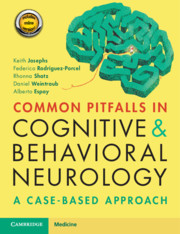Book contents
- Common Pitfalls in Cognitive and Behavioral Neurology
- Common Pitfalls in Cognitive and Behavioral Neurology
- Copyright page
- Dedication
- Contents
- Diseases Discussed in the Book
- Preface
- Acknowledgements
- Abbreviations
- Part 1 Missing the Diagnosis Altogether
- Part 2 Misidentifying the Impaired Cognitive Domain
- Part 3 Missing Important Clues in the History
- Part 4 Failure of Pattern Recognition
- Part 5 Difficult-to-Characterize Cognitive/Behavioral Disorders
- Part 6 Clinical Findings That Are Subtle
- Part 7 Misinterpreting Test Results
- Case 31 Does a Positive Amyloid Scan Always Mean Alzheimer Disease?
- Case 32 Herpes Encephalitis Recurrence?
- Case 33 Refractory “VGKC Encephalopathy”
- Case 34 sCJD with Negative 14–3–3?
- Case 35 You Have Been Diagnosed with Alzheimer Disease; Is That It?
- Part 8 Attributing Findings to a Known or Suspected Disorder
- Part 9 Missing Radiographic Clues
- Part 10 Management Misadventures
- Index
- Plate Section (PDF Only)
- References
Case 35 - You Have Been Diagnosed with Alzheimer Disease; Is That It?
from Part 7 - Misinterpreting Test Results
Published online by Cambridge University Press: 03 November 2020
- Common Pitfalls in Cognitive and Behavioral Neurology
- Common Pitfalls in Cognitive and Behavioral Neurology
- Copyright page
- Dedication
- Contents
- Diseases Discussed in the Book
- Preface
- Acknowledgements
- Abbreviations
- Part 1 Missing the Diagnosis Altogether
- Part 2 Misidentifying the Impaired Cognitive Domain
- Part 3 Missing Important Clues in the History
- Part 4 Failure of Pattern Recognition
- Part 5 Difficult-to-Characterize Cognitive/Behavioral Disorders
- Part 6 Clinical Findings That Are Subtle
- Part 7 Misinterpreting Test Results
- Case 31 Does a Positive Amyloid Scan Always Mean Alzheimer Disease?
- Case 32 Herpes Encephalitis Recurrence?
- Case 33 Refractory “VGKC Encephalopathy”
- Case 34 sCJD with Negative 14–3–3?
- Case 35 You Have Been Diagnosed with Alzheimer Disease; Is That It?
- Part 8 Attributing Findings to a Known or Suspected Disorder
- Part 9 Missing Radiographic Clues
- Part 10 Management Misadventures
- Index
- Plate Section (PDF Only)
- References
Summary
This 51-year-old right-handed woman requested further care for her previously diagnosed Alzheimer disease. Over the previous year, her coworkers observed that she would frequently forget instructions and conversations and increasingly relied on written reminders. She would ask the same question repeatedly and cueing helped inconsistently. Her symptoms had not worsened since. There were no language or visuospatial impairments. Her past medical history included lumpectomy and tamoxifen for breast cancer five years ago, and a 30-year history of alcohol abuse (daily beer and vodka, unknown volume). Indeed, family members reported finding empty bottles of vodka in the garbage. She had no family history of cognitive impairment or other neurologic condition. Previous work up included a normal blood work, brain MRI with contrast, normal cell count, protein, glucose, and cytology in cerebrospinal fluid, but bilateral temporoparietal hypometabolism on FDG-PET (Figure 35.1). With a presumed diagnosis of Alzheimer disease, she was started on donepezil 5 mg daily.
- Type
- Chapter
- Information
- Common Pitfalls in Cognitive and Behavioral NeurologyA Case-Based Approach, pp. 110 - 112Publisher: Cambridge University PressPrint publication year: 2020



